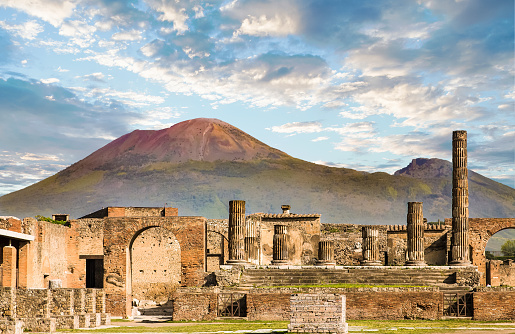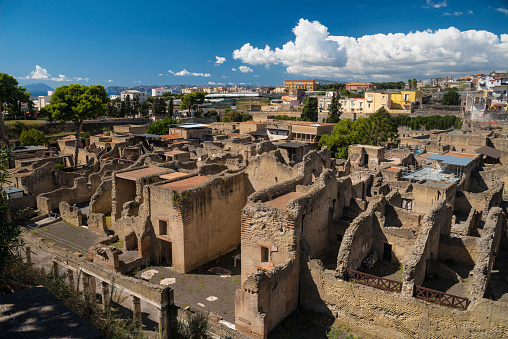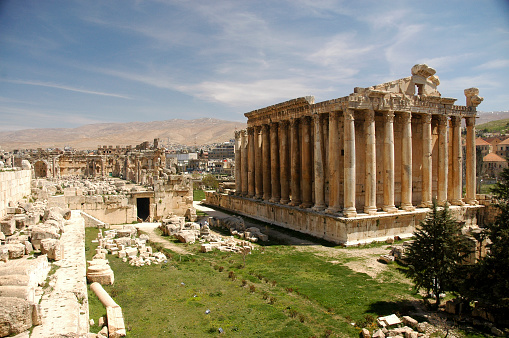Innovation
The Romans were not known to be very inventive themselves when it came to architecture. They adopted styles from the neighboring Etruscans and also the Greeks, and incorporated what was usually a blend of those two styles.
Rather than creating something entirely new, the Romans excelled at another category. The Romans excelled at innovation, taking the styles that already existed and perfecting and improving upon them.
Etruscans And Greeks And Their Influence
The Etruscans (who were a civilization from about 900 BC until they were conquered by the Romans in about 264 BC) and the Greeks (who had been the most prominent civilization in the Eastern Mediterranean from about 900 BC until they were conquered by the Romans in about 146 BC) both predated the Romans and had a great level of influence upon them. Elements of their architecture can be seen in Rome’s architecture.

Pictured above is our idea of how the Etruscan temples appeared. The reason why it is hard to tell today is because they are all just ruins now.
These temples were made out of mud bricks and wood, featured columns only on the front side, and featured a staircase only on one side. These are unique details to the Etruscan temples.

Pictured above is the Parthenon, the most iconic of all the Greek temples. The Parthenon has columns that wrap all the way around and can be entered from any side.
In addition, the Parthenon is not made out of mud bricks, it is made out of marble which was abundant to the Greeks in their peninsula. Now, we shall see how a Roman temple looks in comparison to these two.

Pictured above is the Roman temple at Nimes, which is in France today. This temple was built by Augustus, the first emperor of the Roman Empire.
This temple takes on characteristics of both the Etruscan temple and the Greek temple. From the Etruscan end, you can see that the temple is raised up higher off of the ground and has a staircase only on the front side.
From the Greek end, you can see that the temple has columns which wrap all the way around it. The columns that are up against the inner walls of the temple are called engaged columns.
You can also see that the Romans employ the Greek column styles in their buildings. This column style used here is Corinthian.

Pictured above you can see the ruins of the Roman Forum. It also used a style of building taken from Greek and Etruscan influences.
Another thing that the Romans took influence of from the Greeks is the the theaters. Here is a Roman theater:

There is also a Roman Theatre found at Pompeii. Pompeii was a city covered in ash by an eruption from Mount Vesuvius. The ash preserved a lot of the city’s structures which allows us to see it today.



Roman Innovations
So, with all of this influence, what innovations did the Romans make themselves? Well, one of the most important innovations was concrete.
Concrete already existed meaning the Romans did not invent it, but concrete was not being used widespread. The Romans realized that they did not have enough deposits of marble compared to the Greeks, so they had to come up with a solution to replace the marble with and concrete was the answer.
With concrete, the Romans were able to build way more structures and build bigger structures as well. Also with concrete, the Romans were able to ascend beyond columns and perfect their next innovation: the arch.

Pictured above is Pont du Gard, which shows the scale of what the Romans were able to do with concrete. It would be impossible to do something this stable and of this scale with almost any other material.
Pont du Gard still stands today and it still stands strong, using arches and concrete to support itself and distribute weight evenly. There are many other aqueducts and other concrete structures still standing from the Romans as well.

The Colosseum, also known as the Flavian Amphitheater, was made by the Romans in 81 AD. The arches and interior columns, as well as the concrete composition, allow this structure to stand tall and proud and mark an achievement of man-made construction that had never been able to exist before.
The Colosseum was actually built on top of the ruins of the Golden Palace of Nero, which was torn down because the Roman people were angry at Nero after he died. The name Colosseum comes from the Colossus of Nero, which was basically the only thing left behind from what Nero had once had there.


The pictures above show the inside and outside of the Roman Pantheon. On the front, you can see the influence of the Greeks and the Etruscans.
On the interior, you can also see more Greek influence in the form of Greek column styles. But do you notice the real innovation here? The dome.
See, the Romans adopted the art of the drum–which allowed them to build these circular structures that you can see as the rear portion of the Pantheon–and then on the top they combined arches at angles that allowed them to form a dome.
Before the Romans, the idea of domes barely existed in the world. But now, the Romans had managed to make a roof that was perfectly supported without needing to build anything directly under it to do so.
Some Other Well Preserved Roman Structures

The Roman Bath is one of many ancient bathhouses built by the Romans. The bathhouses were communal places where people went to bathe and socialize.
The one in Bath, England is particularly well preserved. I actually visited it last year!

In the city of Baalbek, there were several prominent temples belonging to the Roman Empire’s eastern provinces. One of those temples was the temple to Bacchus.
The temple to Bacchus is by far the most complete temple left there but there are others as well.


Pictured above are the two other temples that can be found in Baalbek. They are not in anywhere near as good of a shape as the temple to Bacchus, but there is still enough of them left behind to see that they were there.
These are some of the best preserved and publicly viewable monuments left that show the true extent of the Roman Empire at its height. The memory of their culture carries on from the British Isles all the way to Mesopotamia, and perhaps farther.